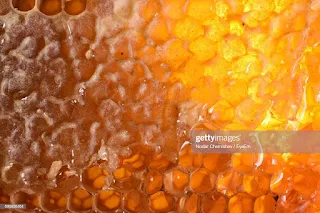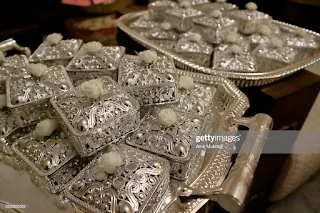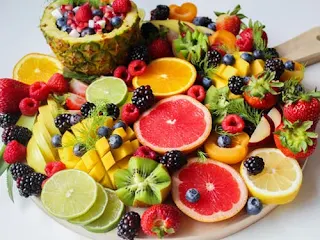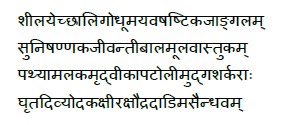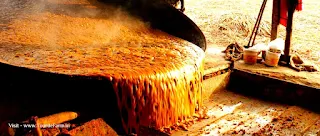Ayurveda
categorize fruits per their impact on the three “Doshas” of the body. Fruits
which are sour in taste usually aggravate “Vata” and “Pitta” and
forms blood in the body but pomegranate is an exception. Let us take a look on
the nature of different fruits:
“Draksha”or
Grapes:
Ripen Grapes
are mentioned as best among the fruits. It is aphrodisiac, good for eyes,
eliminates urine and faeces, unctuous, cold in potency, hard to digest, cures
diseases because of “Vata”, “Pitta” and “Rakta” or blood.It
is cold in potency but is used in cough, fever and respiratory conditions.
“Dadima”or
pomegranate:
Even the
sour or unripe pomegranates do not aggravate “Pitta” but mitigates “Vata”
and “Kapha”. It is not very hot in potency, easily digestible, unctuous
and stimulates digestion.
Banana(Mocha),
Dates(Khajoor), Jack Fruit(Panasa), Coconut(Narikela), Parusaka
or Grewia asiatica, Mimusops Hexandra(Rajdana), Madhuca Longifolia(Madhuka),
Indian Jujube(Badara/Ber), Alangium Salvifolium(Ankola), Ficus
Carica(Phalgu), Lasora (Sleshmataka),
Walnut(Abhisuka Aksoda), Mimusops Elengi(Mukulaka), Pine
Nut (Nikocaka), Prunus
Armenia Linn(Urumanam) are cold in potency and makes the body stout, are
not easily digestible, unctuous, stay for longer in the body, increase “Kapha”
and semen.
Fruit of Tala(Borassus
Flabellifer) increases “Pitta” and moves the bowel. Fruit of Kasmarya
(Gmelina Arborea) is cold in potency, relives the obstruction of urine and faeces,
good for hair, increases intelligence and is a rejuvenator.
Vatama (almond) is hot in potency,
increases “Kapha” and “Pitta” and is laxative.
Buchanania (Priyala/Chironji) is cold in
potency, unctuous and mitigates “Vata”. Its marrow is sweet, aphrodisiac,
mitigates “Pitta” and “Vata”.
Bilva
Phala or Aegle
Marmelos (Bael Fruit) when ripe is hard to digest,aggravates the “Doshas”
and cause flatus. Unripe fruit kindles digestion, mitigates “Vata” and “Kapha”.
Both are water absorbent.
Kapittha or Wood Apple when unripe is bad to
throat and increase the “Doshas”. Ripe fruit mitigates the “Doshas”,
relieves hiccup and vomiting. Both are water absorbent and antipoisnous.
Jambava or Java plum is not easily digestible,
stays long inside stomach, cold in potency, causes aggravation of “Vata”
and mitigates “Kapha” and “Pitta”. It absorbs moisture from urine
and faeces and is bad for throat.
Bala Amra or unripe mango increase “Vata”,
“Rakta” or blood and “Pitta”. When the seed inside if formed
completely, it increases “Kapha” and “Pitta”. When it is ripe, it
is not easily digestible, mitigates “Vata” and increase “Kapha”
and semen.
Vrksamla or Garcinia Fruit is dry, hot
in potency, mitigates “Vata” and “Kapha” and is easily
digestible.
Samya or Sami Fruit is not easily
digestible, hot in potency, destroys hair and causes dryness.
Pilu fruit is not very hot in potency; it
increases “Pitta” and mitigates “Vata” and “Kapha”. It is
purgative, cures disease of spleen, haemorrhoids, worms, abdominal tumours.
When the fruit is sweet-bitter in taste, it mitigates all three doshas.
Matulunga or Citron skin is pungent, unctuous,
mitigates “Vata”. Its fleshy part is sweet in taste, mitigates “Vata”
and “Pitta” and makes the body stout. It is not easily digestible
however the tendril is easily digestible and cures cough, asthma, hiccups, alcoholic
intoxication, dryness of mouth, constipation, vomiting, loss of taste, abdominal
tumour, enlargement of abdomen, haemorrhoids, colic, dyspepsia.
Marking nut
or Bhallataka is cold in potency and makes the body stout. Its seed is
fire in properties, increases intelligence and mitigates “Kapha” and “Vata”.
Palevata is sweet and cold in potency,while
that of sour taste is hot and both are hard to digest. Both cure diseases due
to excessive digestive activity.
Aruka (Prunus Persica Linn) when sweet is
not very hot in potency, digests quickly, sometimes hard to digest and
increases doshas.
Draksha or grapes, Parusaka or Grewia
asiatica linn and Karamardaka or Carissa carandas in their green state
are sour, increases “Pitta” and “Kapha”, hard to digest, hot in
potency, mitigate “Vata” and is laxative.
Kola(Centella asiatica), Karkandhu(Ziziphus
Oenopolia), Lacuka(artocarpus lacucha), Amrataka(Hog plum), Aruka(Prunus
Persica Linn), Airavata(Citrus Reticulata Blanco), Dantasatha, Satuda
and Mrigalindika are sour fruits but do not aggravate “Pitta”
greatly. Also ripened Karamardaka when dried does cause only mild
increase of “Pitta”.
Fruits of Kola
and Amlika(Tamarind) improves digestion, Cause purgation, cures
exhaustion, fatigue and thirst. They are easily digestible and mitigate “Kapha”
and “Vata”.
Note : “Vata”,
“Pitta” and “Kapha” are three doshas of body mentioned in
ayurveda which in balanced state keeps the person healthy.
“Vata”
is gas or air in your body. If aggravated, it causes joints pain and gas
trouble. It is cold in nature.
“Pitta”
is acid and heat in the body. If aggravated,it causes burning sensation, thirst, over hunger
etc.It is hot in nature.
“Kapha”
is cough or lubrication which lubricates the body and puts on weight. It is cold in nature.
<script async src="https://pagead2.googlesyndication.com/pagead/js/adsbygoogle.js?client=ca-pub-7204440794189180"
crossorigin="anonymous"></script>




